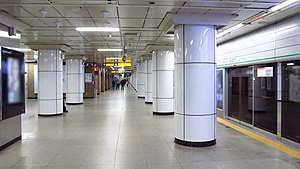Sadang station
Sadang Station is a station on the Seoul Subway Line 2 and Seoul Subway Line 4 in South Korea.
226 / 433 Sadang (Daehang Hospital) Station | ||||||||||||||||||
|---|---|---|---|---|---|---|---|---|---|---|---|---|---|---|---|---|---|---|
 Station Platform (Line 2) | ||||||||||||||||||
| Korean name | ||||||||||||||||||
| Hangul | ||||||||||||||||||
| Hanja | ||||||||||||||||||
| Revised Romanization | Sadang-yeok | |||||||||||||||||
| McCune–Reischauer | Sadang-yŏk | |||||||||||||||||
| General information | ||||||||||||||||||
| Location | 1129 Sadang-dong, 2089 Nambusunhwanno Jiha, Dongjak-gu, Seoul,[1] South Korea | |||||||||||||||||
| Operated by | Seoul Metro | |||||||||||||||||
| Line(s) | Line 2 Line 4 | |||||||||||||||||
| Platforms | 3 | |||||||||||||||||
| Tracks | 4 | |||||||||||||||||
| Construction | ||||||||||||||||||
| Structure type | Underground | |||||||||||||||||
| Key dates | ||||||||||||||||||
| December 17, 1983[1] | Line 2 opened | |||||||||||||||||
| October 18, 1985[1] | Line 4 opened | |||||||||||||||||
| Traffic | ||||||||||||||||||
| Passengers | (Daily) Based on Jan-Dec of 2012. Line 2: 94,735[2] Line 4: 58,545[2] | |||||||||||||||||
| ||||||||||||||||||
Sadang Station has one island platform for Line 4 and two side platforms for Line 2. The Line 2 platforms of this station were the first in South Korea to have platform screen doors installed, on October 21, 2005. This station is the southern terminus for Line 4 trains that belong to the Seoul Metro.
Both platform levels are located in Sadang-dong, Dongjak-gu, Seoul.[3]
Station layout
| G | Street level | Exit |
| L1 Concourse |
Lobby | Customer Service, Shops, Vending machines, ATMs |
| L2 Line 2 platforms |
Side platform, doors will open on the right | |
| Inner loop | ← Line 2 toward Chungjeongno (Nakseongdae) | |
| Outer loop | → Line 2 toward City Hall (Bangbae) → | |
| Side platform, doors will open on the right | ||
| L3 Line 4 platforms |
Northbound | ← Line 4 toward Danggogae (Chongshin Univ.) |
| Island platform, doors will open on the left | ||
| Southbound | → Line 4 toward Oido (Namtaeryeong) → | |
Passenger load
In a survey conducted in 2011 by the Ministry of Land, Transport and Maritime Affairs on 92 administrative divisions across the country, it reported that Sadang Station is the third-busiest public transit stop following Gangnam Station and Jamsil Station. It is followed by Seolleung Station and Sillim Station.[4]
In December 2010 the station is recorded as having the second-highest WiFi data consumption of all the Seoul Metropolitan Subway stations, following Express Bus Terminal Station and followed by Dongdaemun Station, Jamsil Station and Jongno 3(sam)-ga Station.[5]
References
- "사당역" (in Korean). Doopedia. Retrieved 2016-06-17.
- Monthly Number of Passengers between Subway Stations Archived 2014-10-06 at the Wayback Machine. Korea Transportation Database, 2013. Retrieved 2013-10-15.
- "Sadang". Seoul Metro. Archived from the original on 2016-08-10. Retrieved 2016-06-17.
- "Gangnam Busiest Subway Station in Korea". Chosun Ilbo. 23 April 2012. Retrieved 25 April 2012.
- "Seoul Subway Line No. 2 Becomes Major WiFi Hotspot". Chosun Ilbo. 24 December 2010. Retrieved 25 April 2012.
| Wikimedia Commons has media related to Sadang Station. |